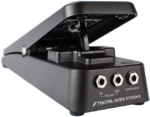Always consult the official Owners Manuals first
Difference between revisions of "Wah block"
m (edited for readability) |
|||
| Line 28: | Line 28: | ||
* '''Funk''' – based on the “Shaft” sound | * '''Funk''' – based on the “Shaft” sound | ||
* '''Mortal''' – based on a Morley wah/volume pedal | * '''Mortal''' – based on a Morley wah/volume pedal | ||
| + | * '''Paragon''' – based on a Tycobrahe Parapedal | ||
* '''VX485''' – based on a Vox V845 | * '''VX485''' – based on a Vox V845 | ||
Revision as of 13:49, 4 December 2022
Contents

Available on which products
- Axe-Fx III: 2 blocks
- FM9: 2 blocks
- FM3: 2 blocks
- Axe-Fx II: 2 blocks
- AX8: 1 block
- FX8: 2 blocks
Channels or X/Y switching
- Axe-Fx III and FM9 and MF3: 4 channels
- Axe-Fx II: X/Y
- AX8: X/Y
- FX8: X/Y
Wah types
- FAS Standard – equivalent to the “Bandpass” setting in earlier firmware
- Clyde – based on an original Vox Clyde McCoy wah
- Cry Babe – based on a Dunlop Cry Baby
- VX846 – based on a Vox V846-HW handwired wah
- Color-Tone – based on a Colorsound wah
- Funk – based on the “Shaft” sound
- Mortal – based on a Morley wah/volume pedal
- Paragon – based on a Tycobrahe Parapedal
- VX485 – based on a Vox V845
Pictures of the real pedals, by MDProd
Other Wah pedals can be emulated by copying frequency range settings from the manufacturer's data:
Factory presets
Many Factory presets have a Wah block.
Position of the Wah block on the grid
Just like actual Wah pedals, the Wah block is usually placed before the amp.
Unless you want to sound like Tom Morello, in which case it should be placed after the Amp block.
Set up a Wah pedal
Read this: Expression pedals, switches, remote control
The Owners Manuals also have a tutorial.
Make sure to calibrate the pedal on the hardware!
Auto-engage the Wah
Similar to an optical Wah pedal, you can engage the Wah block automatically when moving the assigned expression pedal. Especially handy when using a spring-loaded pedal. To accomplish this, set Auto-Engage in the modifier menu of the CONTROL parameter in the Wah block to either a speed or position controlled setting.
Parameters
Tracking
"Tracking controls how much the Q changes with the Control knob. The Q in a wah is not constant. The amount of Q change varies from brand to brand and model to model. It even varies between identical models due to component tolerances." [1]
Fat
"FAT is actually a mix control. It adds dry signal so you can't ever get 100% dry. At max FAT it's 50/50."
Max Freq
Decreasing the maximum frequency allows a high gain Wah tone to cut better through the mix.
Coil Bias / Inductor Bias
This allows the user to adjust the DC offset of the virtual inductor.
"Over time the inductors build up some slight permanent magnetism due to finite DC current through them. This causes asymmetric distortion." [2]
EQ
8-band Graphic EQ (firmware Ares and later).
Output Level
When changing the Wah type, the output level is adjusted automatically because the output of the models has been matched to the original pedals. [3]
"A typical wah has a gain of around 16 dB but it's a bandpass (sort of) response. If your amp is set clean then the output of the amp block will increase by 16 dB when the wah is engaged. Most amps have a response that rises with frequency response. So if the output of the amp block without the wah engaged was, say, 12 dB below full-scale at the high frequencies, it will be 4 dB over full-scale when the wah is engaged." [4]
Tips and tricks
Seek Wah
The Seek Wah is a pedal by ZVEX, which is based on a sequenced filter pattern. For an equivalent effect, assign the Sequencer internal controller to the Wah Control parameter. For a more pronounced effect, add a Formant block, attached to the same controller.
Factory presets are S/Hip Ahoy and Random Wah.
Auto Wah
Read this: Filter block
Fixed Wah
Simulate a fixed Wah position (think "Money For Nothing" by Dire Straits) by setting the Wah Control parameter to a fixed value.
Slow sweep
Attach the LFO internal controller to the Wah Control parameter in the Wah block to create a slow evolving filter effect.
Solving the thump when engaging the Wah
Engaging the Wah can cause a low-frequency thump. This is related to Input impedance.
"The thump isn't the wah, it's the Input Impedance changing. If your preset is set to Auto for the Input Z, when you engage the wah the impedance switches. This causes a slight thump if you are playing since the load on your guitar changes. If you want to avoid this, turn Input Impedance to 1M OHM."
"Set the Input-Z on the preset to 1M rather than Auto. The reason the Wah engages abruptly is because it switches the input impedance. Setting Input-Z to 1M overrides the impedance switch (and, frankly, sounds better IMO)." [5]
The above doesn't apply to Fractal Audio processors with a fixed (not adjustable) input impedance.